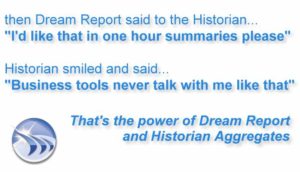 Picture this, you are generating a monthly report and need daily summaries, but your history data has 10 second resolution. That means for the report, you’ll need to process a total of roughly 250,000 data samples per calculated variable. Suppose you could ask your data source to pre-calculate the data for you, for example, telling the source to send you hourly summaries of the data rather than the raw samples. That reduces the data handling to a meager 720 values per calculated variable. These are worst case examples and compression will help the situation, but reports often have dozens of variables, not just one.
Picture this, you are generating a monthly report and need daily summaries, but your history data has 10 second resolution. That means for the report, you’ll need to process a total of roughly 250,000 data samples per calculated variable. Suppose you could ask your data source to pre-calculate the data for you, for example, telling the source to send you hourly summaries of the data rather than the raw samples. That reduces the data handling to a meager 720 values per calculated variable. These are worst case examples and compression will help the situation, but reports often have dozens of variables, not just one.
The ability to reduce the volume of information transferred between products, and offloading some of the calculation to the source is the power of a Historian Aggregate. The aggregation supported by Historians vary. Even with an industrial standard such as OPC-HDA, the client application, in our case – Dream Report, will query the source for the aggregations that are supported and will then expose that list to the user. In the case of proprietary drivers, Dream Report generally supports the aggregation that is in a documented API.
The support of aggregates is a major differentiator between Dream Report and its major competitors, typically business intelligence (BI) tools such as Microsoft SQL Server Reporting Services (SSRS), SAP Crystal Reports and a variety of Excel products and plugins. Aggregates leverage the power and performance of Historian based calculations to minimize the transfer of information to Dream Report and enable Dream Report to perform layered calculations as efficiently as possible.
Just one more great reason to use Dream Report as your reporting and dashboard solution for compliance and performance reporting.

